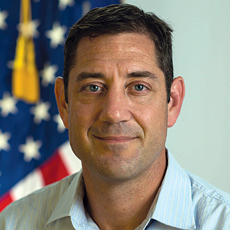
SAN DIEGO — Providers shouldn’t be focusing on the new Nursing Home Compare consumer alert icon, but rather should be concentrating on stopping abuse in long-term care facilities, a Centers for Medicare & Medicaid Services official proclaimed Tuesday.
“Let’s stop debating the icon and let’s start focusing on preventing abuse so that we are compelled in the future to take another look at it because we’ve done such a good job at it,” said Evan Shulman, director of the division of nursing homes at CMS.
Shulman made the comments while addressing attendees during the LeadingAge Meeting & Expo in San Diego via live video link-up from CMS offices in Baltimore.

Providers have called on CMS to rethink the consumer alert icon symbol, which features an open palm in a red circle. The icon is not expected to change, based on Shulman’s comments.
“I don’t think it’s really worth debating what icon we use. I can guarantee if you were to Google other icons for abuse, you will see icons like the one we selected and you will also see ones that are much worse,” he added.
Shulman noted that the icon only applies to facilities that meet certain criteria: facilities that have been cited for ‘G’ harm or higher in the past year’s cycle, or those that have been cited for ‘D’ or higher in each of the last two years.
“Put that together and you get about less than 5% of facilities across the country who have the abuse icon,” Shulman said.
A CMS spokesperson told McKnight’s Long-Term Care News 763 facilities have the icon since the program’s inception a week ago.
Shulman added that the icon brings abuse to the forefront and isn’t “telling (consumers) to turn away.”
“We’re telling consumers to ask questions. One of the things that I think has led to some of the confusion is that CMS seems to be telling consumers to ‘Stop and look some place else.’ But what we are really saying is stop and ask questions,” he said. “It is not a ‘Do Not Proceed’ icon, it is a ‘Stop, Pause and Ask Questions’ icon,” he asserted.
Shulman also addressed the much-anticipated guidance on Phase 3 of the Requirements of Participation, announcing that CMS currently has no date for when it will be released. Phase 3 goes into effect Nov. 28, leaving many providers anxious.
He acknowledged that providers and surveyors both need time to implement and adjust survey process based on the guidance. He added CMS isn’t expecting both parties to immediately be able to implement some of the nuances of the guidance once it’s released.
However, providers are still expected to comply with Phase 3 once implementation day rolls around, he noted.
“We expect there will be an appropriate amount of time for providers and surveyors to implement the guidance,” he said.
In other news from Day 3 at the LeadingAge annual meeting and convention:
• LeadingAge introduced Carol Silver Elliot as its incoming chair Tuesday. Silver Elliot is the president and CEO of the NJ-based Jewish Home Family.
“Ageism must be attacked and we must lead,” she told an estimated 4,000 or more meeting attendees. “ Ageism is insidious and its impact is very real,” affecting philanthropy and policy.
• The association also announced key future meeting dates, among them;
- The next LeadingAge Leadership Summit will be April 20-22, 2020, in Washington.
- The Collaborative Care HIT Summit is slated for June 14-16 in Washington.
- The 2020 annual meeting will be held Nov. 4-7 in San Antonio, with a special Wednesday to Saturday to allow attendees to be at home for election day, Tuesday.




